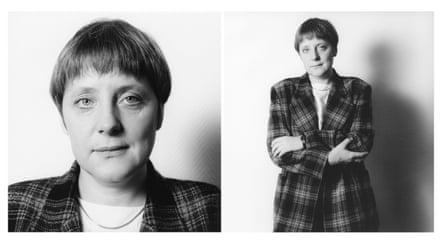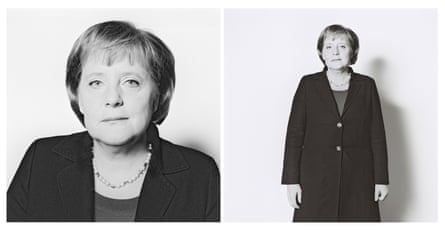Angela Merkel has never been one for Vogue home stories or Desert Island Discs-style moments of intimacy. Sit-down interviews tend to be granted only in the run-up to elections; confidants who leaked stories about her private life in the early days have long ago found themselves banished to the outer hemisphere of power. Given that she is the longest-serving national leader in the European Union, what is surprising about the German chancellor is not just how little we know about her life outside her office, but also how many of the few personal anecdotes we do know about her are based on a single source.
Last winter, when an entire continent was asking itself whether Merkel would run for a fourth term, those journalists who (falsely, as it turned out) predicted that she was about to step down relied almost exclusively on an interview she had given nearly 20 years ago: “Some day I want to find the right way to leave politics,” she had said in 1998. “It’s a lot harder than I used to imagine. I don’t want to be a half-dead wreck.”
To make things worse for political correspondents, the interviewer to whom she had granted that rare glimpse behind the facade was not even a journalist, but an artist, a woman 15 years her senior with whom Merkel shares one of the most unusual relationships in modern politics. Since 1991, with an interval between 1999 and 2006, photographer Herlinde Koelbl has met the German chancellor once every year, taken a portrait and interviewed her, often asking the exact same questions as the year before.
Koelbl’s approach to photography is conceptual, she explains over the phone from her office on the outskirts of Munich. “I will have an idea that knocks around my head for a few years until I come up with the right stylistic device to make it visible.”
For her Traces of Power series, she wanted to record how high office changed a person’s physique. She approached 15 politicians and business leaders who had recently taken on a high-profile public position and were said to have a bright future, and asked them to commit to eight photographs over the next eight years.

“At first I thought it would be a shame to miss out on showing their luxurious offices, their silken armchairs. But then I realised I wanted something more elemental, more formal.” Her sitters were placed in front of a white wall, with no props unless the subjects chose one themselves. Koelbl took two photographs – a close-up and one from a wider angle – and issued no instructions, so that body language was allowed to speak freely.
Over the years, some of the original 15 have withered away on the backbenches or disappeared into other careers; one subject recently died of a heart attack. But Koelbl had a lucky hand: Joschka Fischer, in 1991 an environment minister in the state of Hesse, went on to become the world’s first Green foreign minister and a key figure behind Germany’s opposition to the Iraq war. Gerhard Schröder, at the start of the project the state president of Lower Saxony, became chancellor in the same government.
Merkel had only been a member of her party, the Christian Democratic Union, for a year when Koelbl approached her. Little was known about the former research scientist with a doctorate in physical chemistry other than that chancellor Helmut Kohl had just surprisingly promoted her to be minister for women and youth.
Initially, Merkel was sceptical about the idea: what was the point of a photo project that wouldn’t be published for another eight years? Politicians needed to be in the press tomorrow, she explained. But Koelbl managed to talk her round.
The main thing that struck the photographer during their first encounter was how shy the then 37-year-old politician was. Other subjects in the series opened up in front of the camera immediately. Schröder asked to be photographed smoking a cigar. “That’s how he wanted to be seen,” says Koelbl. Merkel, on the other hand, looked coyly up towards the camera in her first portrait, hands awkwardly folded on her lap.
“Politicians don’t have to be exhibitionists, but they have to love the spotlight,” Koelbl says. “Men are often a lot more vain in front of the camera then women – to an extent they have to be, otherwise they couldn’t stand the pressure. But Merkel was never someone who wanted to move her ego into the spotlight. In that first photograph, her posture expresses a sense of being exposed. And yet even during that first meeting she came across, in her own way, as headstrong.”
By 1996, Koelbl noticed that Merkel’s body language had changed: “She was no longer cramped up. She stared down the lens, chin pointing upwards, body straight. She had became more upright, more self-confident.”
Koelbl usually interviewed her subjects straight after the portrait was taken. In 1996, Merkel told her: “In the past the most difficult thing for me was to stand somewhere and listen to a speech. I never knew where my hands and my whole body should go. But I have improved that now, I no longer wobble from one leg to the other. I’ve become more assured. It’s probably a mix of two things: acting out a role and being at one with yourself.”
The “Merkel diamond”, whereby the chancellor rests her hands in front of her stomach, first appeared in unpublished offcuts from Koelbl’s series in 1998, years before Merkel started using it as a kind of personal trademark in her election campaign.
“Office changes people, not always favourably,” Koelbl reflects. “They learn to put on a mask so that their emotions aren’t so easily calculable. I can’t imagine a tougher job than being a national leader. You are constantly being scrutinised by the public, be it for the dress you are wearing or the sweat patches under your armpits.”

Koelbl’s approach in each session was non-confrontational. “The most important thing for me is that I made my sitters realise that they were under no pressure to perform, they didn’t have to deliver anything.” Three questions ended up forming a framework for each interview with Merkel: “What have you learned this year?”, “What have you unlearned?” and “Did you find the time to bake a plum cake?”
The answers to these questions yield not only detailed discussion of sponge bases, but also some of the few intimate insights into the German leader’s private life on record, touching on her relationship with scientist Joachim Sauer, her childlessness, the difficulty of not gaining weight on the campaign trail and her clumsiness as a child.
Having published Traces of Power as a book in 1999, Koelbl decided to reboot her project in 2006, a year after Merkel was elected chancellor. She says the series will continue “as long as Merkel stays in office”.
When she visited the chancellery earlier this year, she was struck by how the politician hadn’t been visibly affected by a strenuous 12 months that had seen Merkel wrestle with the political aftermath of a migration crisis, Islamic State’s first terror attack in Germany, the departure of a close ally from the European Union and the election of a US president her polar opposite in manner and conviction.
“Normally you can tell from someone’s face if they had a particularly exhausting year behind them. But there wasn’t anything elementally different with her. Her posture hasn’t changed,” Koelbl says.

Like Merkel, who did not enter the world of politics until she was 35, Koelbl decided to become a photographer relatively late in life: aged 37, a friend spotted the pictures she had taken of her four children and encouraged her to take it up as a career. And like Merkel, she has found her path in spite, or because, of being patronised by male competitors: during the Traces of Power project, some male politicians would ask if she had remembered to put a film into her camera. “I don’t mind being underestimated,” she says. “It can be useful.”
Do she and Merkel share a bond that could be described as a friendship? “I am not sure I want to call it friendship,” Koelbl answers, after a moment’s pause. “And I would always be a bit cautious of striking up a friendship with a politician anyway. What you could say, I guess, is that after over a decade there is a mutual respect between us, perhaps even a little bit of goodwill.”
In 1998, Merkel, then general secretary of her party, reflected back on their first seven interviews. “At the beginning I found the questions incredibly annoying,” she said. “I revolted against it and was anything but pleased when you turned up on my doorstep again. I thought: what is this nonsense?
“But then I realised that I found myself asking: has Ms Koelbl been here yet this year? I had to realise that I am apparently vain enough to find your project interesting. Nowadays I am tied to it as a kind of corporate identity. I feel obliged to contribute my part to the success of this thing. The resistance has turned into an acceptance of the project. That’s quite incredible, really.”
- Herlinde Koelbl: Photographs 1980-2016 is on at the Stadtmuseum Tübingen, Germany, until 18 June.
